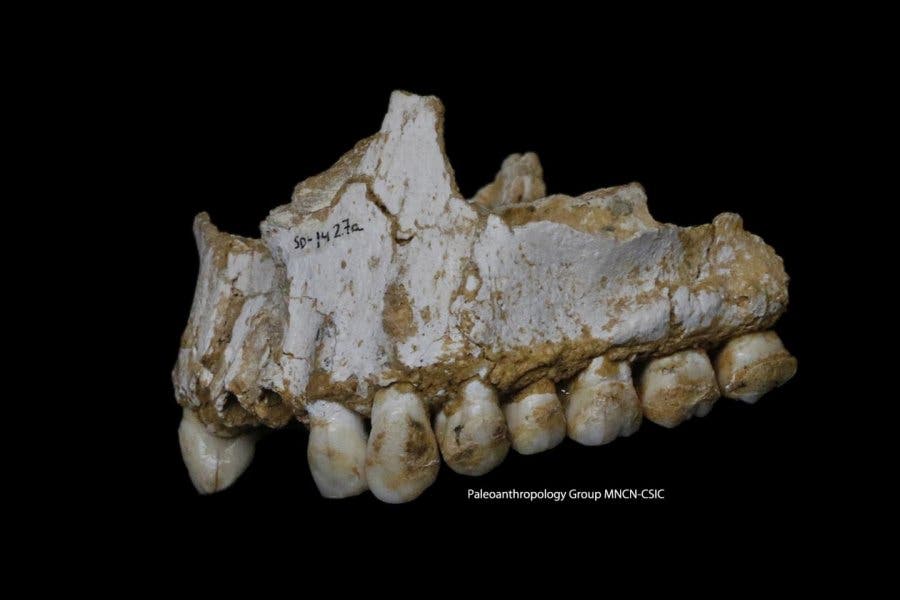Ancient DNA found in dental plaque gives us an interesting glimpse into how Neanderthals self-medicated and interacted with humans.
Ancient plaque

El Sidron upper jaw: a dental calculus deposit is visible on the rear molar (right) of this Neandertal. This individual was eating poplar, a source of aspirin, and had also consumed moulded vegetation including Penicillium fungus, source of a natural antibiotic.
Credit: Paleoanthropology Group MNCN-CSIC
Dental plaque is a biofilm, a mass of bacteria that grows on surfaces within the mouth. It’s commonly formed on and around the teeth. While in the modern world we have ways to deal with plaque, that wasn’t an option for the Neanderthals.
“Dental plaque traps microorganisms that lived in the mouth and pathogens found in the respiratory and gastrointestinal tract, as well as bits of food stuck in the teeth — preserving the DNA for thousands of years,” says lead author Dr Laura Weyrich, ARC Discovery Early Career Research Fellow with ACAD.
She and her colleagues from the University of Adelaide’s Australian Centre for Ancient DNA (ACAD) and Dental School teamed up with the University of Liverpool in the UK to analyze the DNA in the plaque and see what information it yields.
“Genetic analysis of that DNA ‘locked-up’ in plaque, represents a unique window into Neandertal lifestyle — revealing new details of what they ate, what their health was like and how the environment impacted their behaviour.”
They analyzed four samples from individuals who lived between 42,000 to around 50,000 years ago, making it the oldest plaque ever studied. For starters, the plaque showed what the Neanderthals ate. As it turns out, their diet was quite diverse and varied from area to area:
“We found that the Neandertals from Spy Cave consumed woolly rhinoceros and European wild sheep, supplemented with wild mushrooms,” says Professor Alan Cooper, Director of ACAD. “Those from El Sidrón Cave on the other hand showed no evidence for meat consumption, but appeared instead to have a largely vegetarian diet, comprising pine nuts, moss, mushrooms and tree bark — showing quite different lifestyles between the two groups.”
Neanderthals and aspirin

Neanderthals are definitely not the simple brutes we once thought them to be. Credits: Charles Robert Knight
But the most interesting part of the study isn’t what they ate — it’s how they self-medicated. Specifically, one of the Neanderthals had a visible dental abscess on the jawbone, which likely caused immense pain. Analysis revealed he also carried an intestinal parasite that causes acute diarrhea, so he was pretty sick. Well, the plaque of this individual revealed that he was eating a lot of poplar, which contains salicylic acid — the active ingredient in aspirin. Scientists also reported the detection of a natural antibiotic mould (Penicillium) not seen in the other specimens. Penicillium, as you’ve probably guessed it, is the active ingredient in penicillin, which was invented 40,000 years later.
“Apparently, Neandertals possessed a good knowledge of medicinal plants and their various anti-inflammatory and pain-relieving properties, and seem to be self-medicating. The use of antibiotics would be very surprising, as this is more than 40,000 years before we developed penicillin. Certainly our findings contrast markedly with the rather simplistic view of our ancient relatives in popular imagination.”
It’s truly stunning to see how diverse the knowledge of Neanderthals was. They were clearly not the simple brutes we once thought them, as study after study has shown. How did they learn to self-medicate? That’s pretty much ‘educated guess’ territory. The fact that they had some knowledge of the active ingredients in both aspirin and penicillin makes you think.
Another interesting takeaway is how the bacteria in our mouth has changed with the setting of modern life. We rarely think about this, but the tiny bacteria we carry along with us every day have a pretty big impact on our lives.
“Major changes in what we eat have, however, significantly altered the balance of these microbial communities over thousands of years, which in turn continue to have fundamental consequences for our own health and well-being. This extraordinary window on the past is providing us with new ways to explore and understand our evolutionary history through the microorganisms that lived in us and with us.”
Journal Reference: Laura S. Weyrich et al. Neanderthal behaviour, diet, and disease inferred from ancient DNA in dental calculus. Nature, 2017; DOI: 10.1038/nature21674









